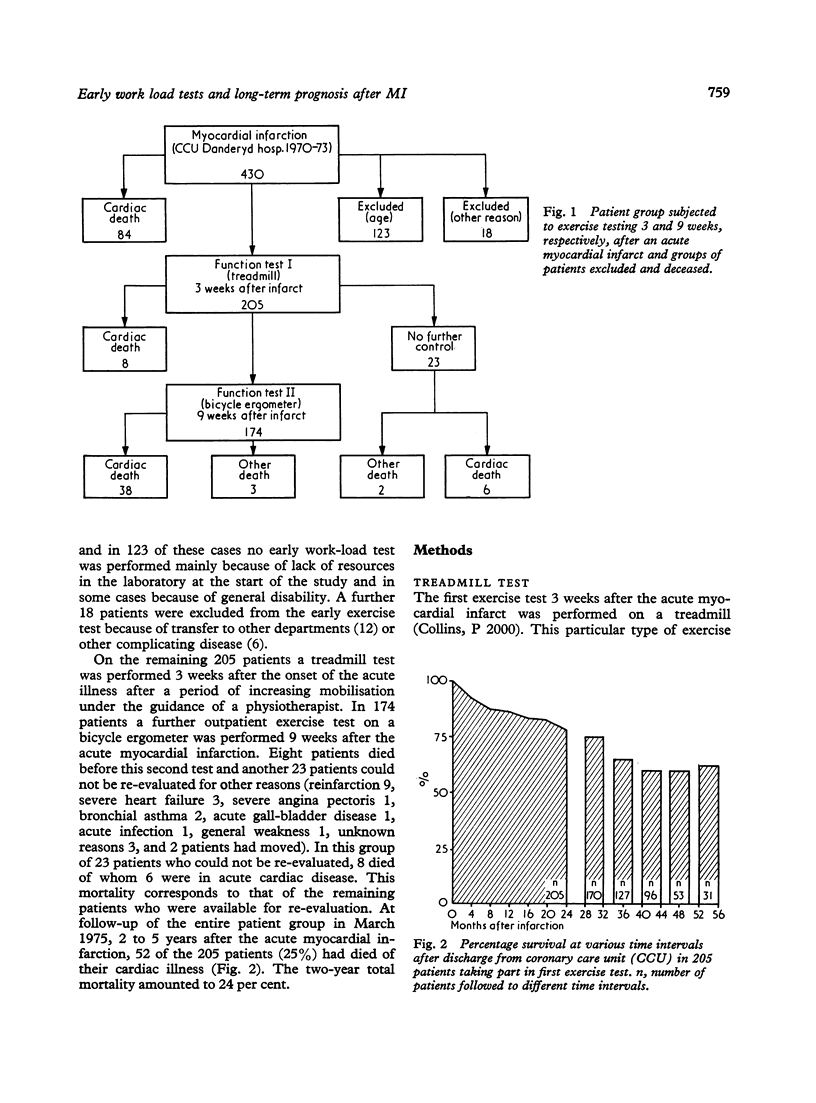Abstract
Exercise tests performed 3 and 9 weeks after acute myocardial infarction in 205 patients were found to give prognostic information on the survival during a follow-up period of 2 to 5 years. The appearance of tachycardia, major ventricular arrhythmias, or anginal complaints during these early exercise tests was thus accompanied by a significantly increased mortality during the observation period. Ventricular arrhythmias disclosed by exercise proved to be of higher prognostic significance than those recorded at rest on the same occasions. The usefulness of early exercise tests in the evaluation of the response to antiarrhythmic treatment after acute myocardial infarction as well as of the prognostic importance of the effects was documented in a smaller series of patients.
Full text
PDF





Selected References
These references are in PubMed. This may not be the complete list of references from this article.
- Crawford M., O'Rourke R. A., Ramakrishna N., Henning H., Ross J., Jr Comparative effectiveness of exercise testing and continuous monitoring for detecting arrhythmias in patients with previous myocardial infarction. Circulation. 1974 Aug;50(2):301–305. doi: 10.1161/01.cir.50.2.301. [DOI] [PubMed] [Google Scholar]
- Ericsson M., Granath A., Ohlsén P., Södermark T., Volpe U. Arrhythmias and symptoms during treadmill testing three weeks after myocardial infarction in 100 patients. Br Heart J. 1973 Aug;35(8):787–790. doi: 10.1136/hrt.35.8.787. [DOI] [PMC free article] [PubMed] [Google Scholar]
- Kentala E., Pyörälä K., Heikkilä J., Sarna S., Luurila O. Factors related to long-term prognosis following acute myocardial infarction. Importance of left ventricular function. Scand J Rehabil Med. 1975;7(3):118–124. [PubMed] [Google Scholar]
- Kosowsky B. D., Lown B., Whiting R., Guiney T. Occurrence of ventricular arrhythmias with exercise as compared to monitoring. Circulation. 1971 Nov;44(5):826–832. doi: 10.1161/01.cir.44.5.826. [DOI] [PubMed] [Google Scholar]
- Kotler M. N., Tabatznik B., Mower M. M., Tominaga S. Prognostic significance of ventricular ectopic beats with respect to sudden death in the late postinfarction period. Circulation. 1973 May;47(5):959–966. doi: 10.1161/01.cir.47.5.959. [DOI] [PubMed] [Google Scholar]
- Lown B., Wolf M. Approaches to sudden death from coronary heart disease. Circulation. 1971 Jul;44(1):130–142. doi: 10.1161/01.cir.44.1.130. [DOI] [PubMed] [Google Scholar]
- Rehnqvist N. Ventricular arrhythmias prior to discharge after acute myocardial infarction. Eur J Cardiol. 1976 Mar;4(1):63–70. [PubMed] [Google Scholar]
- Ryan M., Lown B., Horn H. Comparison of ventricular ectopic activity during 24-hour monitoring and exercise testing in patients with coronary heart disease. N Engl J Med. 1975 Jan 30;292(5):224–229. doi: 10.1056/NEJM197501302920502. [DOI] [PubMed] [Google Scholar]
- Shanoff H. M., Little J. A. Studies of male survivors of myocardial infarction. 8. The electrocardiogram and ten-year survival. Am J Cardiol. 1966 Oct;18(4):535–539. doi: 10.1016/0002-9149(66)90006-3. [DOI] [PubMed] [Google Scholar]


